|
Getting your Trinity Audio player ready...
|
Referral marketing is one of the most effective ways to drive word-of-mouth marketing and grow your business. It’s also an incredibly cost-effective way to acquire new customers.
Referral marketing campaigns often bring businesses more measurable results and higher ROI than other forms of marketing. It also works perfectly for creating brand awareness, driving traffic to your website, and building trust among prospective customers.
What Is Referral Marketing?
Referral marketing entails promoting your products or services through referrals, usually via word-of-mouth, social media channels, website, and review sites. It is a marketing strategy where you encourage happy customers and brand ambassadors to recommend your products/services to their networks.
Word-of-mouth marketing is not new; it has been used by businesses for centuries to drive sales and create brand awareness. Today, the internet has made word-of-mouth marketing easier and more cost-effective for businesses of all sizes. Referral marketing is now a strategic way of approaching potential customers and convincing them to buy your product rather than someone else’s.
While running a referral marketing campaign, you may even want to incentivize customers to refer others to your business. The referred friends or acquaintances then complete some sort of action, such as making a purchase or signing up for membership. The original customer may qualify for a reward for referring to the person.

Why Is Referral Marketing Important?
Referral marketing is important because it uses trust to grow your business. People are more likely to trust peers’ recommendations than sales pitches from the brand itself.
Businesses can then harness customer-brand relationships and get their loyal customers to spread the word. This comes with little to no friction since it’s human psychology to tell friends and family about your good experiences.
What Are the Types of Referrals?


Most people usually think of word-of-mouth when it comes to referral marketing. But there are more types. Let’s explore each of them, one by one.
Word-of-Mouth Referrals
Direct referrals have been around for centuries, becoming the most long-standing means of promotion. All you have to do is approach your repeat customers and ask them for word-of-mouth referrals and promotions. This makes direct referral a cost-effective and powerful way to turn your brand into the talk of the town.
Email Referrals
Email marketing is a proven strategy for communicating with your customers and prospects. The best part? You can go up a notch and utilize this channel for referral marketing.
The problem is most people might be unwilling to write referral emails themselves. For that, it is best to give them a leg-up with templates, text boxes, or CTAs.
Referral From Reviews
A survey by BrightLocal found that around 79% of consumers trust online reviews as much as personal recommendations.
To capitalize on review referrals, consider setting up feedback pages across multiple channels — website, social media, independent review websites, google business profiles, etc. This would allow you to easily pull in customers with a hassle-free, one-stop space.
Case Studies
Case studies are yet another powerful way to draw potential customers. It is an excellent way to showcase the results you’ve seen working with other businesses. For example, you may want to develop a case study around how you helped a business achieve growth or how you solved a problem for your client.
If your client permits, you can use their information in the case, including their names and professional affiliations and how they benefited from your product or service.
Case studies help establish trust and credibility. Plus, they highlight your expertise and help differentiate you from other businesses by demonstrating that you can provide tailored solutions for each client.
Finally, including case studies in your referral marketing strategy can also help to increase your firm’s visibility. By building a reputation for providing high-quality services, you can earn the trust of potential clients who know that you have delivered incredible results to other organizations.
Social Media Referrals
Social media referrals let you promote your business on a digital platform like LinkedIn or Facebook that your leads might be using. Given the hustle and bustle on social channels, social media referrals make a great way to bring your brand to public attention.
Remember that the rise of social media platforms has changed how we interact with the world around us so much so that most people count on social media to share their good and bad experiences with products or services. In fact, there are dedicated pages where millions of members post their feedback about different brands.
The best way to use social media in your referral marketing campaign is to start by inviting your current customers to join your social network. Once they’re on board, request them to share your business’s posts and encourage them to invite their friends. The more people who know about your business and what you offer, the more likely it will be that someone will take the next step and become a customer.
It is also a good idea to ask your customers to share their positive experiences with your product or service in the form of reviews on your social media pages. This can help draw more potential customers to your brand who might look up on social media for products or services.
How to Ask for Referrals [10 Strategies]
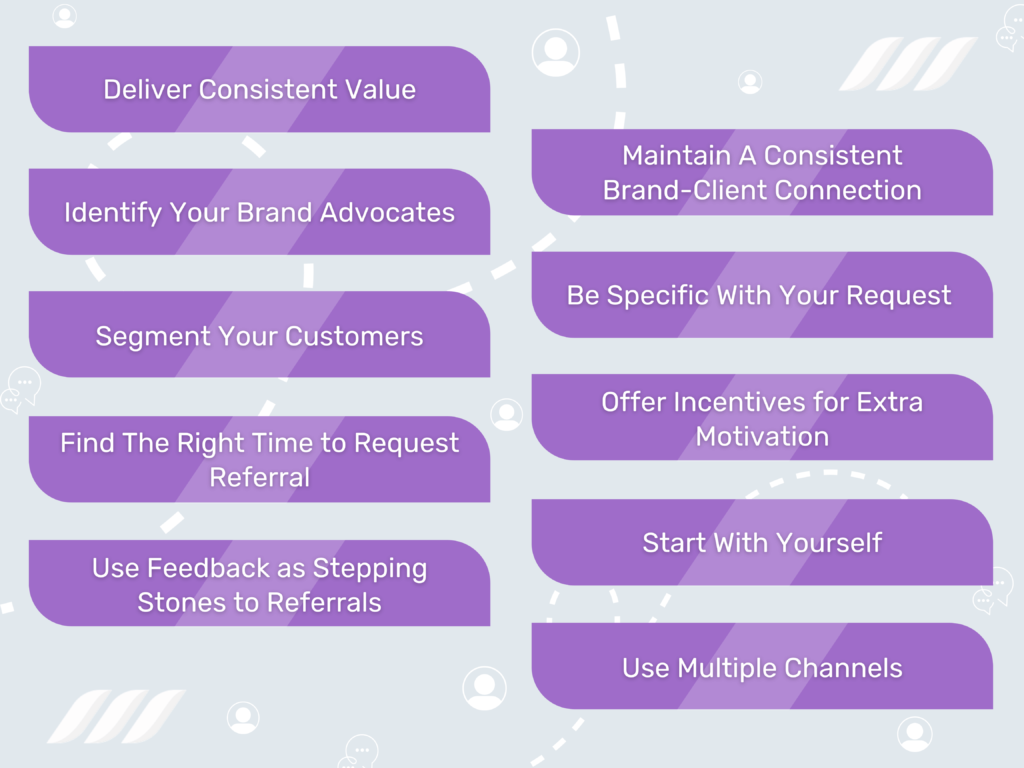

You’re now aware of the types of referral marketing. That’s great, but how do you ask for referrals? Here are 10 proven strategies to help you set the stage. Use these referral marketing strategies to supercharge your sales.
Deliver Consistent Value
It makes no sense to request referrals after closing a deal. Referrals are scored after you’ve won the complete trust of your customers. And that could take some time.
The route to referrals involves bringing value to customers and keeping customer satisfaction as your top priority. This largely means top-notch after-sales support, where you provide immediate support, personalized offers, exclusive announcements, and more.
Remember, asking for favors is easier when you’ve done a favor. Once you’ve established yourself as your customers’ go-to brand, earning referrals will be a cakewalk.
Identify Your Brand Advocates
Why settle for less when you can find people who absolutely love your brand?
Brand advocates are the people who have tried and tested your products/services and are fully satisfied with your brand. You can filter them out by using a Net Promoter Score survey (NPS). This usually centers around one simple question — “On a scale of 1-10, how likely are you to recommend our company/product/service to a friend or colleague?
Those responding with 9 or 10 could be your company’s advocates. You can then provide them with the necessary support to promote your brand, track their performance, and reward them for successful referrals.
Segment Your Customers
Once you have found potential advocates, it’s best to shortlist those with relationship-building ability and authority in your niche. NPS is a promising tool for finding your brand’s “Promoters.” But that doesn’t mean you should sideline those registering 7-8 scores.
These are what marketers call “Passives.” They have the potential to become your brand advocates if nurtured over time using strategies like special offers, solid customer support, and personalized content.
Find The Right Time to Request Referral
From a psychological standpoint, people are most approachable when in a good mood. Has your customer support team just resolved their problem? Consider it a good time to ask for a referral.
Other happy moments could be — when your customers have redeemed rewards to get a big price cut, they’ve left good ratings on your product, etc.
Use Feedback as Stepping Stones to Referrals
Keep an eye on how your customers respond to their positive experiences. If you see them satisfied with your brand, grab that opportunity to ask for a review.
There’s another trick to earning a referral. Sum up your customers’ experience in the form of testimonials. Once you associate their progress with your brand, bringing them on your side will be easier. And when that happens, getting a referral is just one email away.
Maintain A Consistent Brand-Client Connection
Imagine you’ve been lost all along and then resurface only to ask for a referral. How self-serving would your brand appear? To avoid that, ensure you don’t abandon your audience!
Here’s what you can do to let your customers know you’re always there:
- Follow their social media account to be aware of their recent updates.
- Connect with them on LinkedIn and maintain engagement with comments, likes, tags, and shares.
- Maintain appropriate email sequencing, bringing the latest news, initiatives, offers, and questions.
Be Specific With Your Request
It is important to make your referral request natural and well-timed, not awkward and pushy. But you can’t wait for it to happen on its own, do you?
As soon as you engage your customers, consider it time to make a direct, specific, and clear request. Make sure you’re leaving no room for confusion with vague statements or hints.
Offer Incentives for Extra Motivation
You’ll likely run into two types of customers. One, who’d agree to promote your brand with a tad of convincing. Two, those who wouldn’t be interested in publicly expressing admiration for your company.
The latter are the ones you can entice with incentives. While sending out your referral request, mention what you have in store for your brand advocates. Maybe a discount on their next purchase? A gift card? A freebie? You could reward those who leave good words for your brand in so many ways.
Start With Yourself
Take no shame in bringing your loyal customers to the limelight. Speak of their professional facets, how they’re creating a positive difference, and promote their products and services. Doing this will make your customers feel valued, and they may want to return the favor. That’s when you take your chance and ask for a recommendation.
Use Multiple Channels
The more channels you use, the higher your chances of promotion. Why? Because you’ll be targeting diverse audiences across different channels. Therefore, get referrals on your website, social media pages, emails, and everywhere your brand presence could matter.
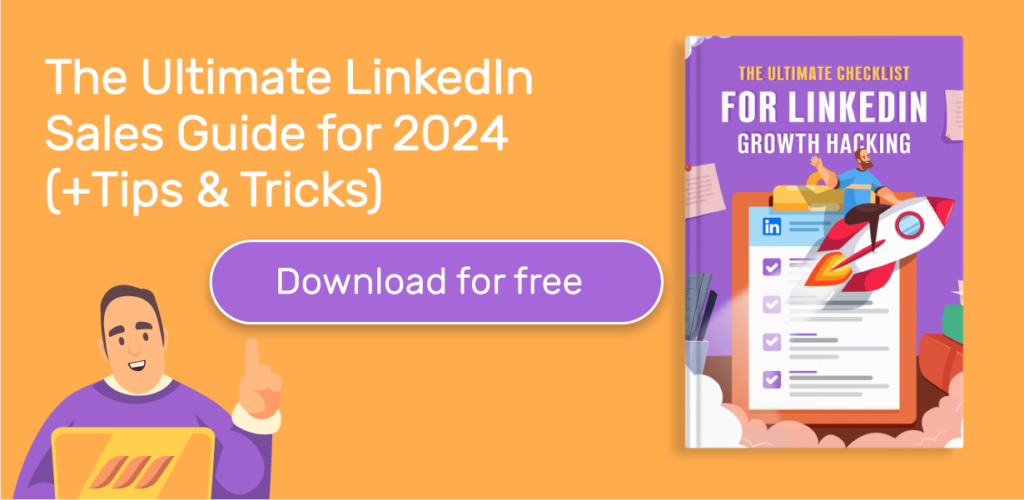

Benefits of Using Referral Marketing
Let’s have a look at the major reasons why referral marketing is important.
Extend Your Reach
Referral marketing is a great way to expand your reach in several different ways. But is referral marketing organic? Absolutely YES! First, it’s an effective way to engage with new customers. If your business has a difficult growing organically, referral marketing is a great way to get more people to visit your website and become customers.
The best part? Referral marketing allows you to reach your potential buyers in a short time frame. Bring in incentives, and you’ll speed up the process even more. This makes it a powerful strategy to get extensive coverage at a minimal cost.
Target Precise Audience
Your existing customers know businesses that need your products and services. So, they’ll selectively recommend your brand to that chunk of their network. As a result, you’ll get targeted customers effortlessly.
Referred Leads Are Easy to Nurture
It is not certain that you’ll have sure-shot customers after referrals. Some recommendations would only result in leads interested in knowing more about your offerings.
However, these people have been somewhat nurtured by their peers. So, you can expect them to convert without rigorous, long-winded nurturing.
Assess Customer Satisfaction
Struggling to get brand promoters? There’s a good chance you’re falling short of your customer expectations.
Referral programs could get your loyal customers on board and highlight how your brand is performing. If your existing clients are not ready to recommend your brand, it’s time to improve your customer service.
High Return on Investment
According to the American Marketing Association, referred customers tend to spend 200% more than regular customers. Not just that, but they also have 37% higher retention rates. These benefits assure you that the efforts you’ll put into referral marketing will pay off in many ways.
How to Ask for Referrals
Read on for everything you want to know about asking for referrals on different channels.
How to Ask for Referrals on Social Media


If you have social media profiles of your target promoters, you can conduct your outreach then and there. How? By directing your post toward that buyer group or keeping your message general.
You can acquire referrals across every social media channel — Facebook, Instagram, Twitter, LinkedIn, and so on. Among all platforms, LinkedIn is the best place to run your social media referral campaign.
Thanks to its powerful features, LinkedIn makes approaching referrals much more convenient. Apart from the direct messaging feature, you can use dozens of different ad types to get your point across.
Also, the sponsored InMail feature allows you to connect with people outside your network. So, if you don’t have a 1st-degree connection with your potential brand advocates, you may want to use this feature.
The best part? LinkedIn has recently introduced the “Ask for a Referral” button. With this, job candidates can send automated referral requests while applying for jobs.
LinkedIn also supports an array of automation tools, which make sales and marketing campaigns like prospecting, scraping, and lead nurturing much easier. Take Dripify, a sales automation tool, for instance.
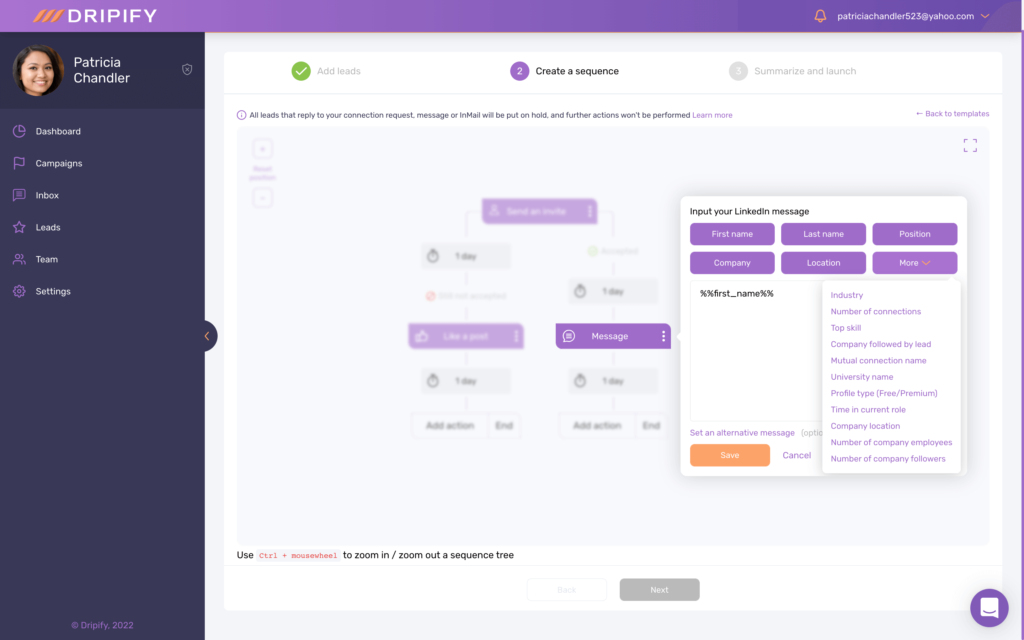

Thanks to its automated messaging feature, Dripify allows you to send referral requests to multiple customers at once. This tool is powered by a super advanced algorithm that mimics human behavior precisely to steer clear of LinkedIn detection.
How to Ask for Referrals on Your Website
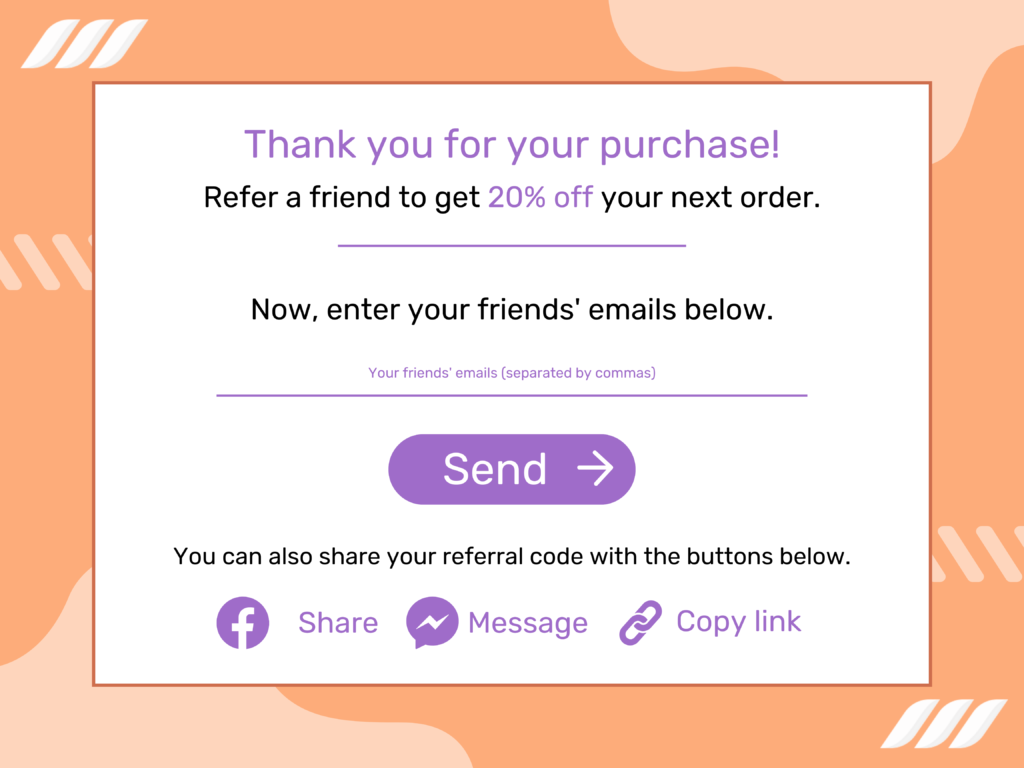

Your website is your company’s face. Since it is a usual place of visit for your repeat buyers, you may want to use it as an opportunity to get referrals.
One way to do that is by integrating a pop-up message with compelling visuals and a clear CTA button. It could go something like — Love our service? Tell your 10 friends about it and get 10% off your next purchase. You can then follow up with a referral page link where they’d complete your desired action (email, link sharing, social media).
For more effective results, think of adding a referral pop-up strategically. For instance, it is a good idea to integrate a pop-up that asks for referrals right after a customer completes a purchase or leaves feedback.
How to Ask for Referrals Via Email
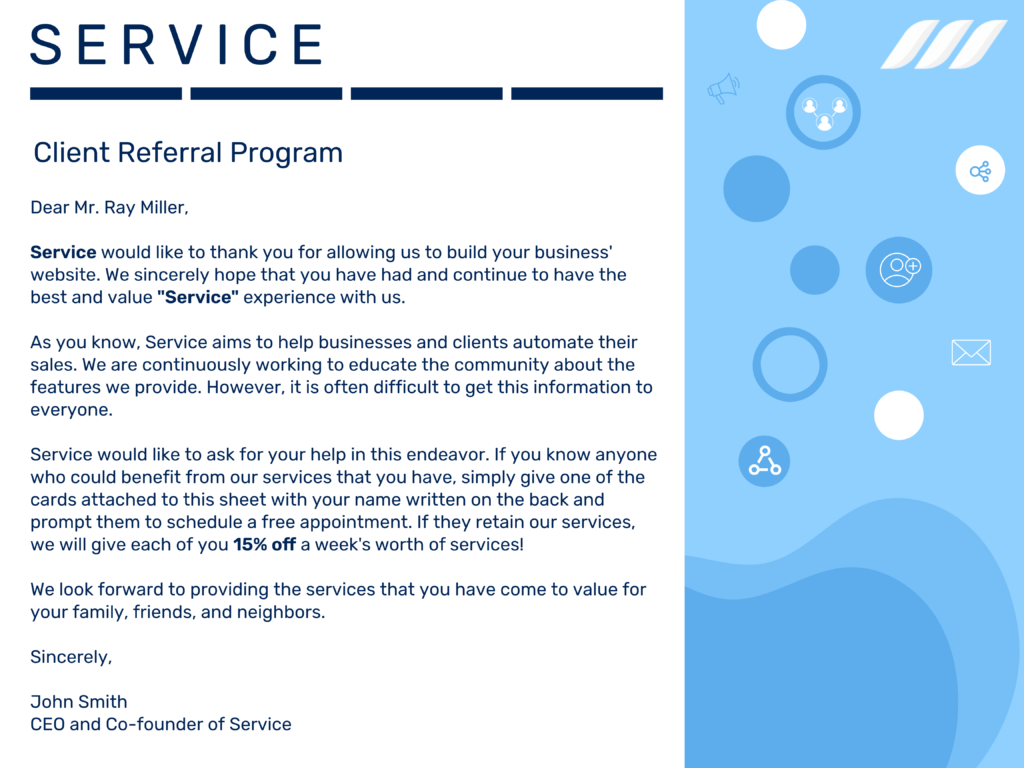

Emails are a fairly straightforward way to ask for referrals. For best results, it is important to set up a message sequence with a referral being requested at least. Consider this example scenario:
- A customer purchases your product.
- You send a thank you email for their purchase.
- You check up with them a few days later, asking how their product/service is performing.
- If everything’s fine, send an email requesting referrals.
Once you create a natural email flow, keep your message personalized, clear, and polite. But more importantly, keep it short and sweet. All you need to provide is a nudge to onboard those already on your side.
Besides creating and sending a dedicated referral email, you may want to add a short note at the end of every email or even embed it in your email signature.
How to Write a Referral Email
Let’s dive deeper and explore different aspects of writing a successful referral email.
Plan Appropriate Email Structure
Before composing your email, it’s important to spend some time planning for your email.
For starters, focus on the subject line, as it’s the first thing people will see. Make sure to keep it catchy, specific, and suggestive without revealing too much. Second, think of something to build upon, a strong reason for contact, and the possible incentive you want to offer.
Personalize Your Email
Write your email based on the customer profile. Think of their buying habits or unique interactions you’ve had with them to support your email. Once you successfully draw their attention, cement a stronger connection with a hook.
Here’s an example: Hi Mike, it’s been a while since you’ve shopped for our wristwatches, and we admit to having missed you. But guess what? We’re here with an exclusive offer for you.
Maintain A Friendly Tone
Believe it or not, people detect computer-generated messages at a glance. So, the last thing you’d want is to make your message robotic and monotonous.
Make sure to keep things fun and engaging. More importantly, avoid being too aggressive or using a forced or demanding tone. Despite highlighting mutual benefits, be sure the recipients are at ease with your request.
Deliver at The Right Time
Make sure to get your message across when your target customers are most receptive to external emails. Avoid busy hours as they’d probably prioritize their work-related emails during that time over others.



Customer Referral Email Templates
For medium to large businesses, it isn’t practically possible to write a referral email every time. A more fitting solution is to get a bunch of referral email templates and use them to save time.
Let’s have a look at three different referral email templates, each with a unique use case.
Template 1: For a new customer
Hi [Customer name],
I’m so happy to know you’ve had a wonderful interaction with our support team. We’re honored to know you shopped with us, and we’ll make sure to continue providing stellar service.
If you have any questions, you can contact our support team anytime. In the meantime, do you know anyone who could use our [product/service name]?
If so, let me know their contact details, or feel free to refer [Your company or product name] to them.
Regards,
[Your name]
Template 2: For a loyal customer
Hi [Customer name],
Thank you for continuing your trust in us for [customer need]. As you’re one of our most loyal and valued customers, we take great pleasure in serving you.
I was wondering if you have someone in mind who could benefit from [your company product/service]? If so, could you help them connect with us?
You can click on this referral program link to share our brand with them: [link].
Your time and efforts greatly matter to us.
Therefore, we’re delighted to offer you [reward] when a customer makes their first purchase with your referral link.
Thank you again,
[Your name]
Template 3: After a positive review or comment
Hello [Customer name],
We saw that you left us a [review/comment], so we wanted to express our gratitude personally.
We’re happy that [need that was met based on the feedback]. Thank you for recognizing our efforts to provide the best service to our customers.
Since you have shared your happy experience with us, we believe you want the same for others. We’d like to join hands so that maximum people could benefit from us.
If you know someone who is on the lookout for [product/service], please refer them using our referral program link: [link to referral program page].
The best part? You’ll get [reward] when someone clicks on this link and [mention suitable action].
Have a great day!
[Your name]
Difference Between Referral and Affiliate Marketing
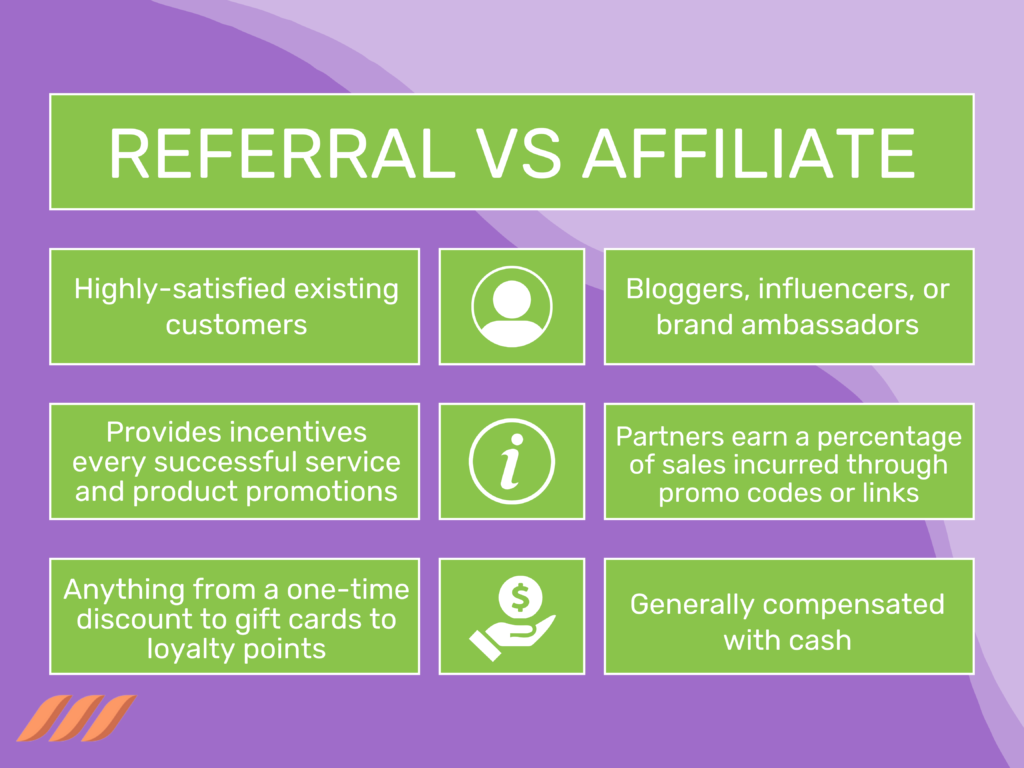

The involvement of incentives might create confusion between referral and affiliate marketing. Let’s differentiate the two types by understanding the core concept.
B2B referral marketing targets highly-satisfied existing customers by providing incentives every time they successfully promote your products and services. These incentives could be anything from a one-time discount to gift cards to loyalty points.
By contrast, affiliate marketing seeks brand promotions from bloggers, influencers, or brand ambassadors. These people haven’t necessarily used your products or services and are generally compensated with cash.
The average affiliate program has a link or promo code, which allows affiliate partners to earn a percentage of sales incurred.
The bottom line is that you approach your happy customers or fans while conducting referral marketing. With affiliate marketing, however, you’re interested in people with an established status in your niche and a well-defined audience, such as social media influencers.
Conclusion
As you’re pouring resources into different marketing strategies, you don’t want to exclude referral marketing, do you? This underappreciated marketing strategy offers the best of simplicity, cost-friendliness, and usefulness.
That said, asking for referrals at the start could be tricky. So, to sum up, follow this checklist for a successful referral marketing campaign.
- Identify your desired referral types based on your target audience’s presence.
- Lay the groundwork right (consistent value, segmented audience, etc.).
- Find the right time and opportunity to make your request.
- Entice your customers with incentive-based campaigns.
- Ensure your message is well-structured, personalized, and follows a friendly tone.
- Use the mass automation feature of the top LinkedIn automation software like Dripify to scale your campaign’s productivity.
- Depending on your use cases, plug, tweak, and play with referral email templates.

![How to Write a Price Increase Letter [Tips, Examples, and Free Template]](https://dripify.io/wp-content/uploads/2021/12/27.png)
![How to Write an Effective Collaboration Email [+Templates]](https://dripify.io/wp-content/uploads/2023/05/13.png)



